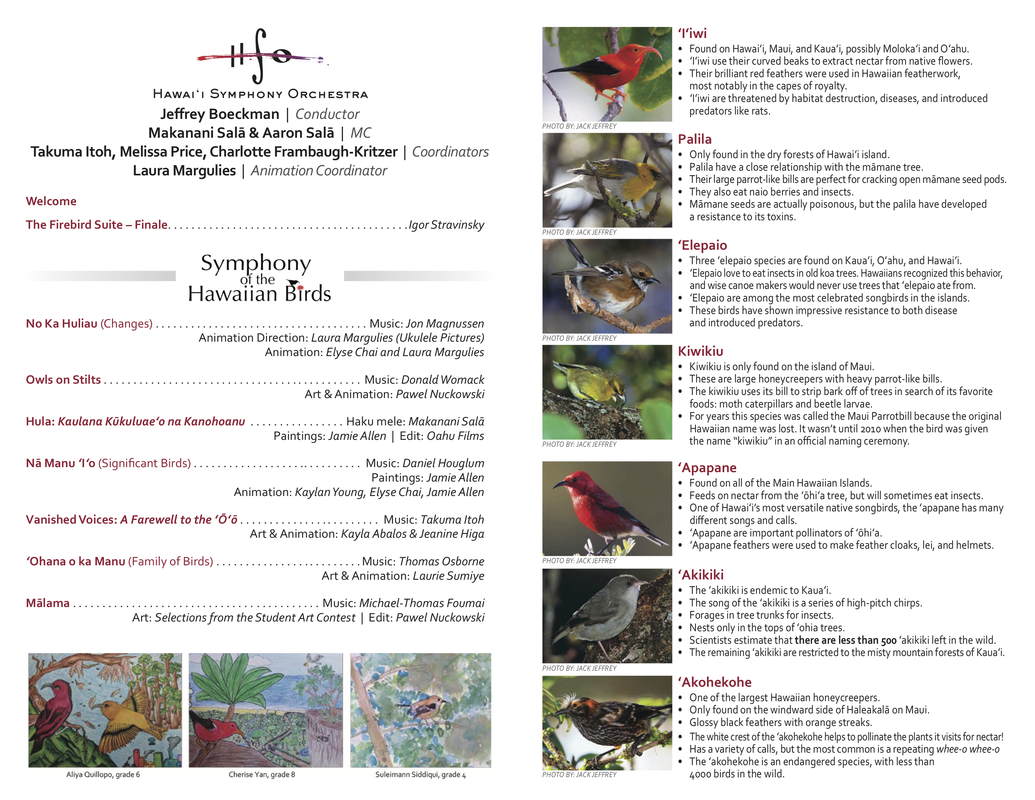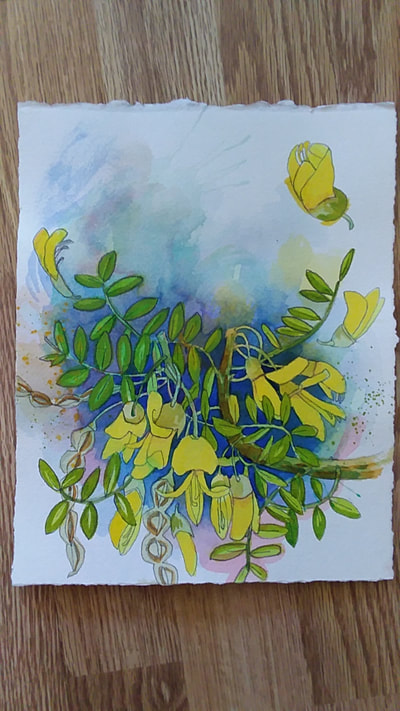|
See a video feature and a news article by UH News on our most recent concert that took place on Oct. 31 and Nov. 1.
2 Comments
Read all about our May 9, 2018 concert here! Includes pictures and links to a couple of videos.
Megan Laut is a Wildlife Biologist with the U.S. Fish and Wildlife Service and a primary scientific consultant for our project. She contributed vital knowledge to one of the performance's final compositions on Hawaiian forest bird conservation, spearheaded by artist Laurie Sumiye and composer Thomas Osbourne. Ms. Laut works with Kaua‘i forest birds such as the ‘akikiki and ‘akeke‘e, two critically endangered honeycreepers that are threatened by imminent extinction unless conservation actions are implemented. ‘Ākikiki, one of several critically endangered Kaua‘i forest birds in need of drastic conservation measures. (Photo by Jack Jeffrey) Tell us about yourself: where you’re from, how long you’ve lived in Hawai‘i, and where you work? I grew up in Delaware, moved to the Big Island in 1996 after graduate school, moved to Oahu in 2001, and have been working at the U.S. Fish and Wildlife Service for over 10 years. What are some of the major challenges faced by Hawai‘i’s native forest bird species? Hawaii’s forest birds face many of the same challenges, regardless of which island they are on. These include predation by non-native mammals, habitat loss and degradation, and mosquito-borne disease. Further, most people don’t get to see these birds because they occur in remote places. Because of this, many people aren’t familiar with them, or don’t relate to them like they might to, say, a mynah bird which isn’t native, but people see every day. Public awareness about these species is necessary for their conservation, and this is one of the reasons I’m so enamored with the Forest Bird Symphony Project. Children are learning about the birds in the classroom, but will also get to encounter them through a sensory experience, which provides the opportunity to relate to them at an emotional level. What role does the U.S. Fish and Wildlife Service play in local forest bird conservation efforts?
The Service works with a number of partners in a variety of ways to conserve Hawaii's forest birds. In addition to national wildlife refuges like Hakalau Forest that provide some of the last, best habitat for forest birds in Hawaii, we are engaged in a number of field projects with DOFAW, the San Diego Zoo, and others to restore habitat, provide support for captive breeding efforts for bird's like Kauai's ‘akikiki, combat invasive species like mosquitoes that spread avian pox and malaria, and find solutions to threats like rapid ‘ōhi‘a death. We are also responsible for developing recovery plans and identifying the actions that are needed to improve the status of the species. What are some of the important takeaway messages you would like to communicate through this performance? I would most like the audience to leave with an appreciation of the uniqueness and beauty of Hawaii’s forest birds. Several months ago, we shared some early sketches of Hawaiian forest birds created by Ms. Jamie Allen, a talented local artist and a primary collaborator for the symphony project. Originally from New Jersey, Ms. Allen received her Bachelors of Fine Arts from the Rhode Island School of Design, later acquiring her Masters of Fine Arts from Montclair State University. Her artwork has been displayed in collections and exhibitions around the world, and her brilliant illustrations of Hawaiian landscapes and floral assemblages are prominently featured in the Halele‘a Gallery. We checked in with Ms. Allen last week as she continued her visual animation work for the final symphonic performance. Left: Artist Jamie Allen (right) and co-animator Kaylan Young working on an ‘elepaio animation sequence. Right: These crimson i‘iwi cutouts are among the many dazzling visual recreations of Hawaiian forest birds that will populate the performance. How did you first hear about the Hawaiian Forest Bird Symphony Project, and how did you become involved as a collaborator? I became involved in the Hawaiian Forest Bird Symphony Project after Laura Margulies approached me in November. I was shocked that she wanted me to be one of the artists since I have never animated. She felt strongly that my style would translate well into an animation and believed we could make it work. This project was one of those moments when you say YES to something that is completely out of your comfort zone, but you believe in the mission of the project. I wanted to acknowledge my two co-animators - Kaylan Young (editor) and Elyse Chai whom I would not have been able to complete this project without their help and dedication. Your paintings have been praised for their vibrant and contemporary depictions of Hawaiian flora. What is your creative process for visualizing subjects in the natural world? Why thank you! I tend to think of work as taking specific subjects from the natural world, combining them with the language of painting/mark-making and creating an imagined environment where all of the elements align. The foundation of my practice lies within combining my daily life and the process of using paint as a means of articulation. Painting for me is a tool to understand the world and to find personal balance. The diaristic approach fueled by curiosity, interactions, research, and observation becomes a play between knowledge and expression. Everyday encounters and objects merge between the figurative and the literal. Whether it is a specific location, a conversation, a particular plant, or piece of literature, each contributes to the complexity of the piece. The history within the layers of painting and drawing is a dialogue about time, growth, and life; exposing an environment that takes on meaning within and beyond plant or ocean matter. My life’s purpose is to continually re-define beauty and to reveal elements overlooked. I create in order for these environments to thrive. A stunning array of ‘ōhiʻa blossoms provide a backdrop for some of the animation sequences. What materials do you use in your artwork? I painted about 20 backgrounds that would remain stationary in the animation. These were done on watercolor paper using watercolor, acrylic, pencil, and pen. For the birds, bugs, flowers, text, and miscellaneous items I made them out of cut paper. I drew and painted on them with watercolor, acrylic, and pen. I wanted the paper to really stand out against the still paintings, so I used various papers and even one that was made entirely of glitter. Cut paper really lent itself nicely with stop motion animation. I probably made about 40 birds. This project provided me with a greater appreciation for the amount of time animators put in. A flock of paper ‘elepaio! These native monarch flycatchers were revered as ‘aumakua by some canoe-making families, and were often pivotal characters in Hawaiian mythology. How did you determine which Hawaiian birds your team would focus on? We were given the section “Native Hawaiian Birds Important to Hawaiian Culture". We immediately chose the i‘iwi for its importance to the Hawaiian Monarchy. Since the i’iwi is a fairly well-known native bird, we felt that having two birds would make for a more dynamic animation. One of the other animators, Laurie Sumiye suggested we focus upon the ‘elepaio. The ‘elepaio’s significance is to guide the canoe makers to the right koa tree for making a canoe. Mythologically speaking, this bird is also seen as the wife of Kū - who is the forest god. Even though there are several more birds that are important to the Hawaiian culture, we felt that these two birds provided a good starting point. Q5: What are some of the qualities of the birds that you highlighted in your artwork? After working with the Hawaiian specialist on my team, it was apparent that I wanted to depict these birds in their natural environments before the introduction of current predators. It was important to me to illustrate these birds in their natural habitat surrounded by native plants and bugs. I included the names of the plants so that the viewer can be aware of what they were surrounded by and what they ate. I highlighted the colors of the birds (red and brown) and the general characteristics of the birds so that the students could easily identify them next time they see one. In the simplest way possible, my goal was to show how these birds moved in their habitat and how they became of importance to Hawaiian culture. The i‘iwi animation sequence in progress, two i‘iwi cutouts ready for their closeups! Q6: Did you learn anything about Hawaiian forest birds through your involvement in this project? YES YES YES. Birds and Beyond! From the very first presentation on the endangerment of native Hawaiian Forest Birds, to drawing in the Botany, Entomology, and Vertebrae collections at the Bishop Museum, extensive online research, talking to biologists from the USGS, getting into the mind of my composer - Daniel Houglum, studying the cloaks/capes/headdresses via collections of the Queen Emma Summer Palace and Bishop Museum - where I also learned important facts talking to the staff, emailing Noe for fact checks and correct wording for the Hawaiian language (Google is not reliable), to last but not least - how to animate! I really experienced firsthand that a project of this caliber needs a team to complete it. I was humbled on how honest and generous my team was and how we all worked together for such an important cause. Saying yes to a path unknown really has had its many gifts. For more of Jamie Allen's artwork, visit http://www.jamierallen.com/
Makanani and Aaron Sala have created an amazing new hula for this project. Check out their videos showing not only the hula, but also a series of explanations of each of the verses. You can learn about how the Hawaiian canoe makers of the past were guided by the ‘elepaios, or where you can find the palila nowadays and what they eat.
Learn a Hula About Native Birds! During our meeting with the composers, artists, scientists, and conservation experts at the Bishop Museum in December, we had the chance to take a look at some of Haruo Uchiyama's latest creations: extremely life-like carvings of Hawaiian forest birds. The Dec. 17/Jan. 18 issue of "Hana Hou!" the Hawaiian Airlines magazine features an article on Uchiyama, a master woodcarver from Japan who has specialized in sculpting birds. He was (is?) in residence at the Bishop Museum, working to create a number of wood carvings of endangered and extinct Hawaiian forest birds. Because the feathers of the actual specimens in the Bishop Museum collection are easily damaged when exposed to light, they cannot be displayed for any extended length of time. These carvings will allow the museum to display life-like sculptures on display indefinitely. You can read more about him and his Hawaiian bird woodcarving project here:
Bishop Museum blog (April 19, 2017) Hawaii Public Radio Broadcast (Sept. 23, 2016) Haruo Uchiyama's website Mr. Uchiyama's blog, including some photos of his working process |
Melissa Price
|
Proudly powered by Weebly














 RSS Feed
RSS Feed